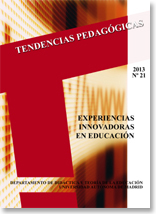Keywords:
Singapore method, Infant Education, mathematics, handling, teaching-learning process.Abstract
This paper analyzes the teaching-learning process applied in Singapur (country first in several studies as PISA and TIMSS). This method is based on visual elements that enhance problem´s understanding. Our main contribution is to complement the learning process incorporating the sense of touch and manipulation as the main mode of discovering mathematics concepts in the preschool Education.Downloads
References
Arainz, P. (1991) Evolución y contexto de la práctica psicomotriz. Edit. Amaru Ediciones, Salamanca, 75-93.
Baroody, A. J. (1989) “Manipulatives don’t come with guarantees”. Arithmetic Teacher, 37(2), 4-5.
Baroody, A. J. (2003) “The development of adaptive expertise and flexibility: The integration of conceptual and procedural knowledge”. In A. J. Baroody, & A.
Dowker (Eds.), The development of arithmetic concepts and skills (pp. 1-33). Lawrence Erlbaum Associates, Mahwah, NJ.
Bautista, J. M. (2001) Criterios didácticos en el diseño de materiales y juegos en Educación Infantil y Primaria Agora digital, Nº. 2, ISSN-e 1577-9831.
Berdonneau, C. (2008) Matemáticas activas (2-6 años). Biblioteca de Infantil. Grao.
De Castro, C. (2007) La evaluación de métodos para la enseñanza y el aprendizaje de las matemáticas en la Educación Infantil. Unión: Revista Iberoamericana de Educación Matemática (11). pp. 59-77.
Fernández Bravo, J.A. (2008) Didáctica de la Matemática en Educación Infantil. Madrid, Grupo Mayéutica.
Gil, M. D., Vicent, C. (2009) Análisis comparativo de la eficacia de un programa lúdico-narrativo para la enseñanza de las matemáticas en Educación Infantil.
Psicothema, Vol. 21, nº 1, pp. 70-75.
Lee, S. K., Goh, C. B., Fredriksen, B., Tan, J. (2008) Toward a Better Future. Washington, District of Columbia: World Bank and National Institute of Education, Nanyang Technological University15.
Morrison, G. S. (2005) Educación Infantil. 9ª Edición. Pearson Education.
NCTM. (2000). Estándares Curriculares y de Evaluación para la Educación Matemática. Granada: SAEM THALES.
NCTM. (2003). Principios y Estándares para la Educación Matemática. Granada: Sociedad Andaluza de Educación Matemática Thales.
Parcerisa, A. (1996) Materiales curriculares. Cómo elaborarlos, seleccionarlos y usarlos. Barcelona: Graó.
Piaget, J. (1979) Seis estudios de psicología. Edit. Seix Barral, Barcelona, p. 12.
Pons, E y Roquet-Jalmar, D. (2003): Desarrollo cognitivo y motor. Edit. Altamar, Barcelona, p. 12, 105-12.
Tek, K. (1994) Primary Math Textbook 1A. U.S. Edition. Third edition.Marshall Cavendish Int (S) Singapur
